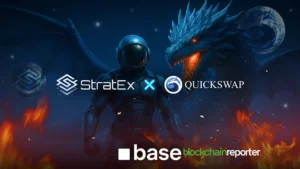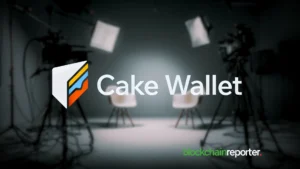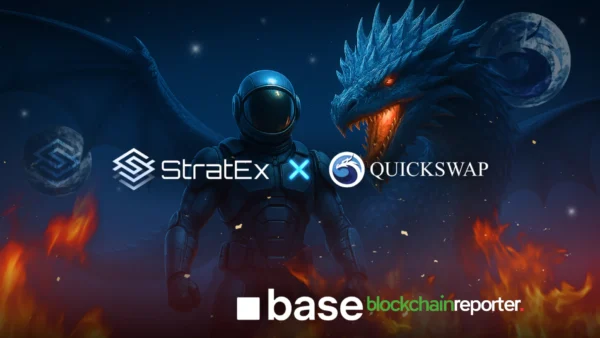
With the financial landscape rapidly evolving, institutional adoption of Bitcoin has become a hot topic, influencing not just market values but the very fabric of blockchain development. Amidst this shifting paradigm, Bill Laboon, the Director of Education and Governance Initiatives at the Web3 Foundation (W3F), offers a deep dive into the consequences and opportunities borne from this new era of cryptocurrency integration.
In this exclusive interview, Laboon shares his insights into the burgeoning relationship between traditional financial institutions and the anarchic world of blockchain. From the impacts on the Web3 development landscape to the changing public perception of cryptocurrencies, Laboon provides a comprehensive overview of the current state of play and what the future may hold.
As institutional entities like Britain’s financial watchdog begin to embrace crypto-backed instruments, and Bitcoin itself ascends to unprecedented heights, the implications for developers, users, and educators in the blockchain space are profound. Through Laboon’s expert lens, we explore the evolving challenges and advantages facing the blockchain community, the vital role of education, and the ongoing quest for software quality and user-centric design.
Q1. With the recent approval of crypto-backed exchange-traded notes in Britain and the record surge in Bitcoin price, how do you anticipate institutional adoption of BTC impacting the overall Web3 development landscape?
I think over the last few years, we have moved to a place where real institutions want to see more blockchain development and understand the rationale for it. And I think that’s going to bring a lot more serious developers, not that there aren’t serious developers in this space now. But it’s going to bring you more serious developers, more tools, and more developer interest in the Web3 development space.
Q2. How do you think developments like this will affect the public’s perception and understanding of crypto as well as blockchain technology?
Similarly to the shift among developers, the general public is also becoming more comfortable with understanding blockchain technology. In the early days, about ten years ago, it was perceived as something shady, used for underhanded activities. However, perceptions are changing. People are starting to realize that blockchain technology is actually the opposite: it is for those who want to engage in activities in a transparent, provable, and trustless manner, enabling users to understand the code behind the services they use.
As this understanding grows and as people observe that even large, conservative institutions are beginning to trust this technology, the public’s appreciation of the benefits of blockchain will deepen. Consequently, there will be a growing demand for technology that allows individuals to own their data and for the use of Web3-based systems that facilitate this.
The acceptance and understanding of blockchain technology are gradually permeating the public consciousness. There has always been a group of people who understood its potential. As an educator, both at the Web3 Foundation and previously at the University of Pittsburgh, I have seen individuals delve deep into this technology and envision its possibilities. Now, it’s becoming increasingly easier for the general public to feel comfortable with cryptocurrency and to understand blockchain technology and its benefits through various events and educational efforts.
Q3. Education is extremely important for the general public in the crypto and blockchain industry because it’s not an easy topic. What do you think about it?
There’s a plethora of complex technology involved when you turn on a light, much of which operates behind the scenes. I’m sure that in the 1800s when Maxwell was formulating his equations, people questioned their practical utility. But today, we clearly see their impact; we can turn on a light or use a computer.
This mirrors the challenge we face in explaining blockchain technology. It’s not so much about conveying the intricate mathematical details, but rather about demonstrating how it can make a difference in people’s lives. What are the practical applications? What can individuals actually do with it? This is the focus of our efforts, though it’s admittedly a slow process.
Q4. In your view, what could be the potential challenges and opportunities for developers in the blockchain space as a result of increasing institutional interest in Bitcoin?
I believe there’s always a tension in software development and technology—probably in many other areas too—between unbridled chaos and experimentation versus standardization and safety. As we witness increased institutional interest in Bitcoin and other distributed ledger technologies like Polkadot, which I work on, we’re approaching a crucial juncture. This spectrum stretches from unbridled experimentation, with no standardization where people try all sorts of novel things—characteristic of the blockchain over the last 15 years—to a phase of maturation.
We’ve seen a sort of Cambrian explosion: diverse approaches and innovations. But as technology matures, we’re discerning what is effective and what is not. For example, Bitcoin, operating on a proof of work system, consumes significant electricity. It has its benefits and drawbacks, but we’re observing a shift towards new systems that adopt proof of stake, which is more energy-efficient since it utilizes existing on-chain elements rather than electricity to create new blocks.
This shift indicates we’re learning what works, but it also highlights a potential issue: decreased willingness to experiment. There seems to be an increase in copycats—systems that replicate methods proven effective in other contexts without innovation. Institutional interest reinforces this trend, as they often prefer proven methods, creating a challenge to innovate under the pressure to conform. However, while sticking to tried and tested methods offers safety, groundbreaking innovations have emerged from unprecedented experimentation, though not without risks.
We’ve witnessed significant failures, such as the collapse of blockchain networks like Terra Luna with its algorithmic stablecoin—an ambitious experiment that ended disastrously. As technology evolves, it often faces more constraints, a scenario that holds both pros and cons. With rising institutional interest, we may see more of these constraints. However, within these limitations lies both a challenge and an opportunity. By understanding what works and operating within certain boundaries, we can develop solutions that are significantly more beneficial for the end user.
Q5. Can you discuss the potential impacts of this rising adoption on software quality and testing within the blockchain space?
Just as background for this question, I used to teach software testing and quality assurance. I actually wrote a whole textbook on it. And so it’s something I’m very passionate about. So this is sort of the intersection of software quality I like and I’m passionate about blockchain. And this is definitely an intersection. So I think that as this adoption continues, you’re going to see more focus on software quality.
I’ve been working in blockchain technology in one way or another since 2012. So that’s 12 years. We saw in the early days, there was not a lot of focus on easy usability, which is part of testing and understanding the user experience. This is something people are focusing on as more people use it. They want something that’s just going to work and that requires a high level of quality testing. And so we’re already seeing more demand for this.
People want to see that code audits have been done. People want to see that the testing has been done. I know at Polkadot, we have worked to improve our testing since it started. We now have numerous testnets out there where as you compare to Bitcoin, which just kind of launched without a testnet. So with Polkadot, we have several testnets and before anything is launched, we have Kusama, our Canary network, which is a real network with your actual value behind its tokens.
So there’s a huge pipeline from the internal unit tests to integration tests that are running on a testnet to putting on Kusama first and putting it on Polkadot. This is a very different path than the original Bitcoin which had a thinking like, ‘Let’s launch it and see what happens.’ So in general, I see this rising adoption, providing a lot of incentivization for more testing and thus more quality, which again has benefits and drawbacks.
So the big benefit is for the end user though and I think that they then get your higher quality software, not just in terms of lack of bugs, but also in terms of the user experience. Things that developers would be fine with dealing with but we know that end users won’t be fine with dealing with so I do think this has been a good thing. This increasing adoption has been good evolutionary pressure for blockchains, who test well, and to make sure that they’re producing quality software.
Q6. In your opinion, what are the critical skills and knowledge areas that blockchain developers should focus on to stay relevant and impactful in such a landscape?
When people are less interested in blockchain, developers also tend to lose interest in developing for it. However, the early release versions of Polkadot saw a large number of developers and an increasing interest. I could mention tactical aspects, such as Rust development, which is significant not only for Polkadot but also for other ecosystems like Solana.
Rust development is crucial, but I view it as a tactical detail. The best developers in any blockchain ecosystem are those who understand the fundamentals of blockchain. This is because blockchain and Web3 represent a different paradigm. I often joke that you can’t just sprinkle “blockchain dust” on something and expect improvement. It’s essential to understand the benefits and drawbacks of using blockchain, recognizing that it involves working in a distributed system, which adds complexity. One must consider what benefits this complexity brings and the drawbacks of having an immutable ledger.
There are systems, such as Subsquid, that base their entire business on making blockchain data easier to query by using different storage mechanisms. Understanding the fundamental principles of blockchain, including hashing and the various types of cryptography, is crucial. Those who take the time to understand what blockchain is and how it works can then apply this knowledge broadly. They can learn any specific language or framework required because they grasp these fundamental concepts.
The Web3 Foundation offers an online course, Web3x on edX, that covers the basics of blockchain. This course is highly recommended as it helps people understand the benefits of blockchain. Alternatively, if my teaching style isn’t to your liking, there are many other resources available on the fundamentals of blockchain. Investing time in understanding these fundamentals is crucial before moving on to learning specific languages simply because they are currently popular. It’s important to establish a solid understanding of the basics first.
Q7. As someone deeply involved with the Web3 Foundation, could you elaborate on how W3F is preparing or supporting developers for this shift towards institutional adoption of cryptocurrencies?
Yes, so we really have three main focuses related to this: education, research, and grants. In terms of education, I’ve already mentioned that we offer courses not just on Polkadot but on broader blockchain concepts and understanding Web3, emphasizing its philosophy. Besides teaching courses, I also engage directly with individuals from government agencies, businesses, corporations, foundations, and other ecosystems.
Part of my job, as I see it, is to educate people to help them understand not just how these things work, but also why we are doing all of this, which can sometimes be challenging for people to grasp. Another area we focus on is research. We have around 13 or 14 researchers on staff, all holding PhDs. They conduct a range of studies from fundamental cryptographic research, like zero-knowledge proofs, to specific areas such as economics and governance.
We publish numerous papers; you can see our work at Research.web3.foundation, where we aim to educate the academic community and advance blockchain technology. Finally, there are grants. We provide financial support to teams building the infrastructure and tools that will be useful for corporations. In software development, large institutions often integrate various tools into one comprehensive project rather than developing each small project independently.
Through our grants, we ensure that essential components, like block explorers and development tools, are available to those in our ecosystem, enabling a robust environment for building. This approach has been effective, especially with Polkadot, where we consistently rank high in terms of developer engagement in our ecosystem. Our focus is on ensuring that not just corporations but also individual developers have the financial support and resources they need to build on Polkadot. Education, research, and support for development are our primary goals.
Q8. The Polkadot protocol is a flagship project of the W3F. How do you see the adoption of crypto influencing the development and adoption of Polkadot and its ecosystem?
So, I would say that, although I might be biased, Polkadot is ideally suited for institutional work. For teams looking to build in an ecosystem, Polkadot allows you to create your own blockchain, setting your own rules. You can decide the degree of centralization or decentralization you prefer while still benefiting from Polkadot’s ability to interact with other blockchains. Currently, there are 50 different blockchains within the Polkadot network, making it a true network of blockchains.
Institutions often use existing components rather than building everything from scratch. Polkadot embodies this approach, enabling a blockchain to perform specific functions and interact with other existing blockchains, thus leveraging their capabilities. From a technical perspective, we envision that many large corporations and government entities will want to operate blockchains in conjunction with existing public blockchains. This has been the design goal from the start. In our interactions with companies, we learn what they find challenging, what works for them, and what features they are looking for.
We maintain a cycle of feedback where they tell us their needs, and we strive to meet them, fostering productive exchanges, including regulatory aspects. From a regulatory perspective, Polkadot has proven very useful. After extensive discussions with regulatory agencies, we announced in 2022 that Polkadot and its token are classified as software, not as security. This has been crucial since many entities seek regulatory clarity.
This stance has been shaped by our continuous work and interactions with these entities, recognizing that no large corporation wants to engage in activities lacking regulatory transparency. This focus on regulatory clarity has significantly influenced our path and efforts. So, I can see how these factors—both technical and regulatory—have shaped our development and direction.
Q9. As an author and educator, how do you approach the topic of cryptocurrency and blockchain technology in your teachings, especially in light of recent market developments?
Yeah, to be honest, I’m a technical person, so I don’t pay much attention to market movements, although I acknowledge they influence others’ interest in the technology. My focus in teaching is to convey the benefits of blockchain technology — the ‘why,’ not just the ‘how.’ There’s an old saying, though I can’t remember who said it off the top of my head: “If you want people to build a boat, don’t just hand them a hammer and nails; teach them to yearn for the sea.” That’s the understanding I aim to instill. Why are we building this boat? Why are we venturing out there?
This approach underpins all my teaching. Before even starting to teach, whether to a computer science student interested in programming or anyone else, it’s crucial to explain why it’s beneficial to engage with this technology. My focus is on ensuring that the structures people build are provable, trustless, radically transparent, yet secure.
At the Web3 Summit, which is organized by the Web3 Foundation, we use the slogan “Less trust, more truth.” This encapsulates the essence of blockchain technology perfectly. With blockchain, you can demonstrate exactly what code is running and what will happen. While not everyone may understand this at first glance, we can teach people how to verify what’s happening and foster trust in this trustless system.
This is achievable through the concept of provability, which is a major aspect of credibility and a significant focus of my educational efforts. I am indeed interested in the ‘how,’ the specific details, but the main goal of my teaching is to help people understand the ‘why.’ Why are we pursuing this technology? In a world rife with trust issues and problems, I see blockchain technology as an amazing solution to many of these challenges.
Q10. Lastly, what are the most exciting trends you’re observing in blockchain development, and how might they influence the broader tech landscape?
Yeah, the most exciting aspect, if I had to choose just one, would be DAOs and on-chain governance. These Distributed Autonomous Organizations allow individuals from around the world, who may not know each other or anything about each other, to interact trustlessly and achieve goals. Polkadot, which I am most familiar with, is essentially what we consider the world’s largest DAO.
All upgrades to this $12.6 billion network are controlled by the holders of the DOT token. Developers cannot make any changes without the agreement of DOT holders. There’s an on-chain treasury with over 38.7 million DOT, approximately valued at $340 million, controlled solely by DOT holders. There could be tens of thousands, perhaps even hundreds of thousands or millions of DOT holders worldwide. It’s difficult to ascertain the exact number from on-chain data since one person can have multiple accounts.
Nevertheless, these holders collectively control a significant treasury and decide on aspects like where to allocate funds, how to upgrade the network, and which parameter changes to implement. As of this morning, there are 59 different referendums up for vote. This phenomenon is remarkable. We’re seeing people take Polkadot as an example and form their own DAOs around various topics and goals. While I’m discussing Polkadot, I want to emphasize that this trend extends beyond just one platform.
Interview Summary
As our conversation with Bill Laboon draws to a close, the key takeaways from this dialogue are both enlightening and significant for the future trajectory of blockchain and cryptocurrency. Laboon, with his depth of experience and keen insight, underscores the transformative power of institutional Bitcoin adoption on the Web3 development landscape. This shift is not merely a financial evolution but a technological and cultural revolution, altering the way developers, users, and the general public perceive and engage with blockchain technology.
The increased interest and participation from institutional entities not only validate the legitimacy of cryptocurrency but also pave the way for a new era of innovation, standardization, and utility in the blockchain sector. Laboon’s emphasis on education, the importance of understanding the core principles of blockchain, and the critical role of software quality, illuminate the path forward for developers and enthusiasts alike.
Furthermore, his perspective on the integration between traditional financial systems and emerging Web3 technologies offers a glimpse into a future where digital and traditional assets coexist and complement each other, fostering a more inclusive, transparent, and efficient global financial ecosystem.
As we reflect on Laboon’s insights, it becomes evident that the journey of blockchain and cryptocurrency is still in its early stages, filled with potential and promise. The convergence of institutional adoption, technological innovation, and community engagement, guided by visionary leaders like Bill Laboon and organizations like the Web3 Foundation, signals the dawn of a new chapter in the digital age, marked by empowerment, transparency, and unprecedented opportunities for growth and collaboration.









